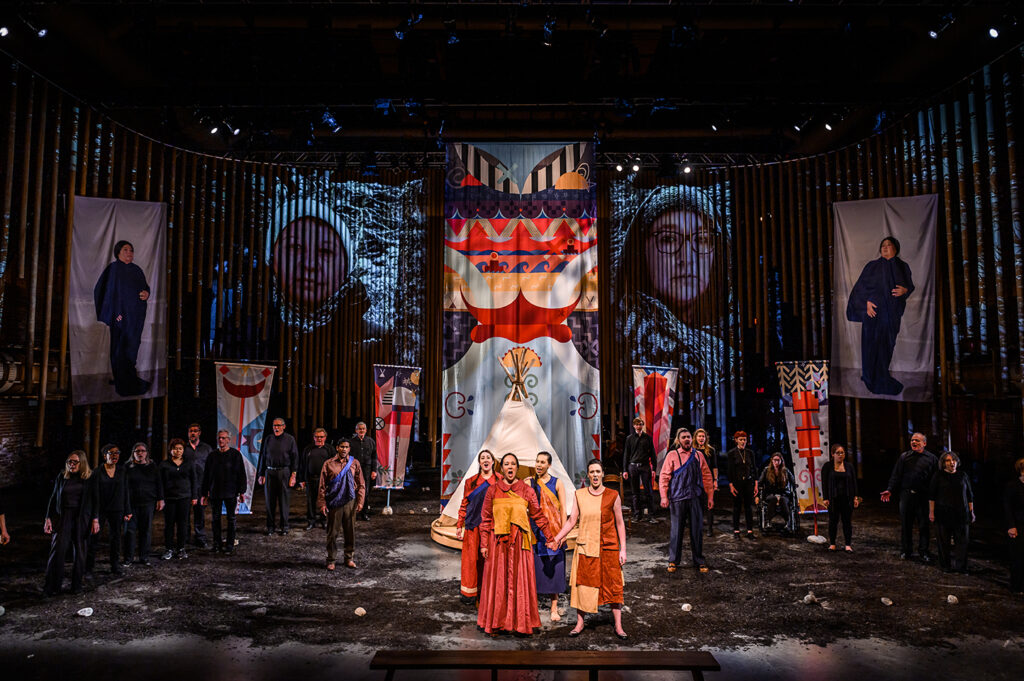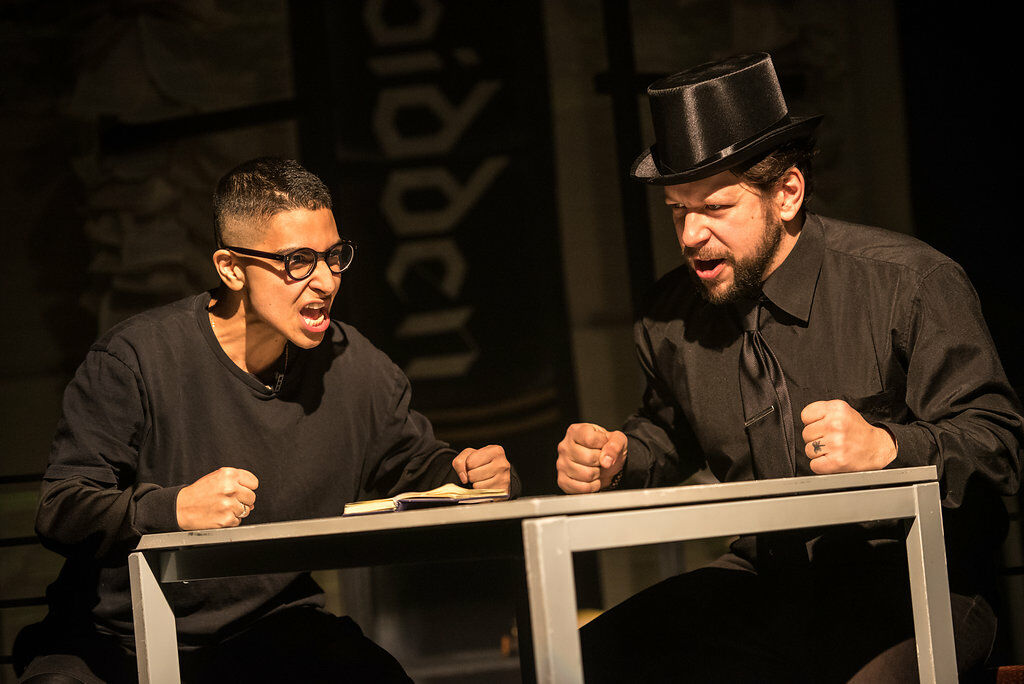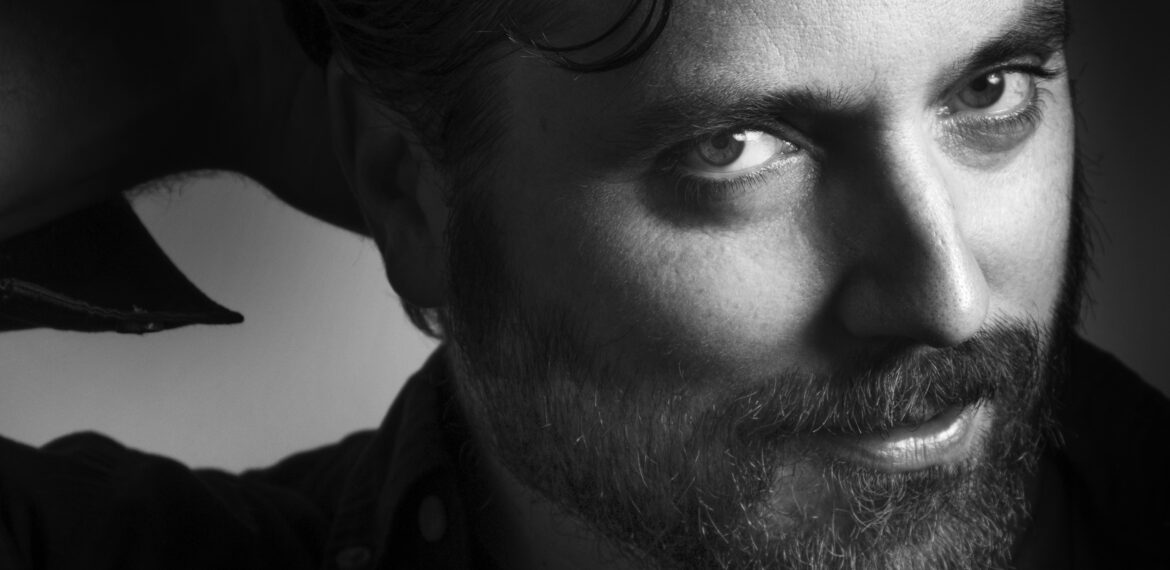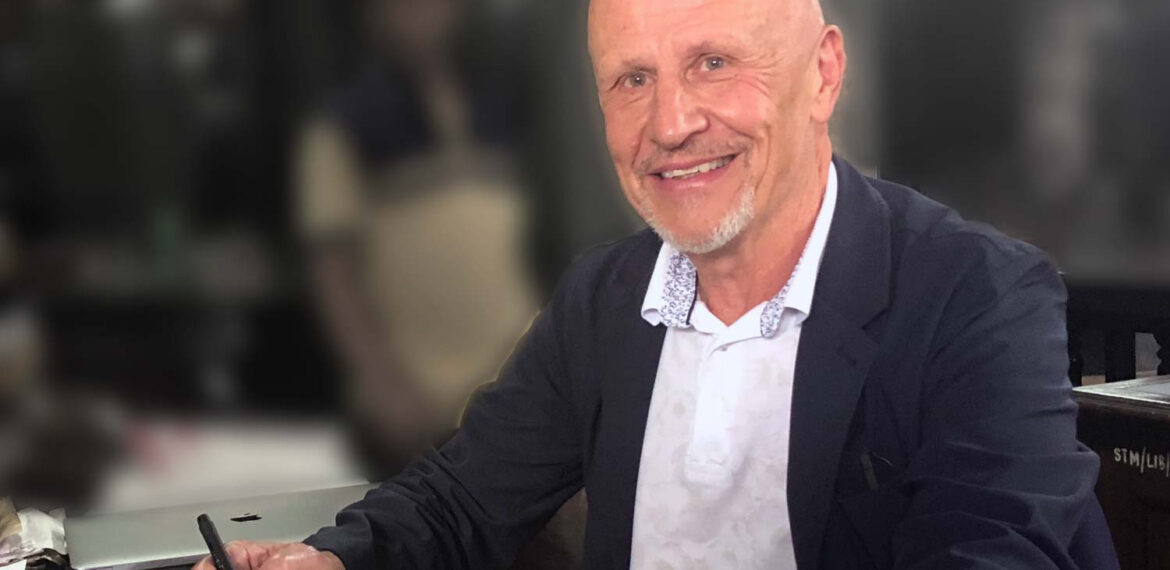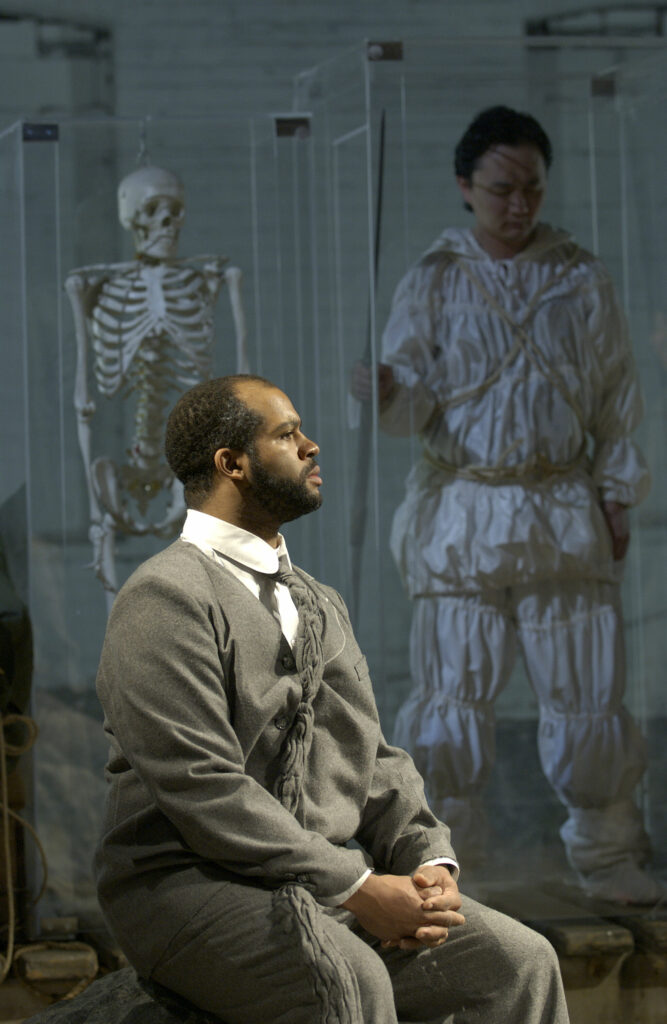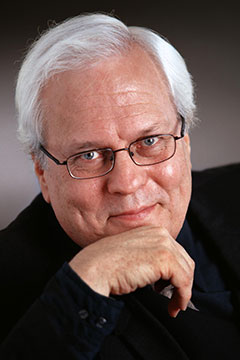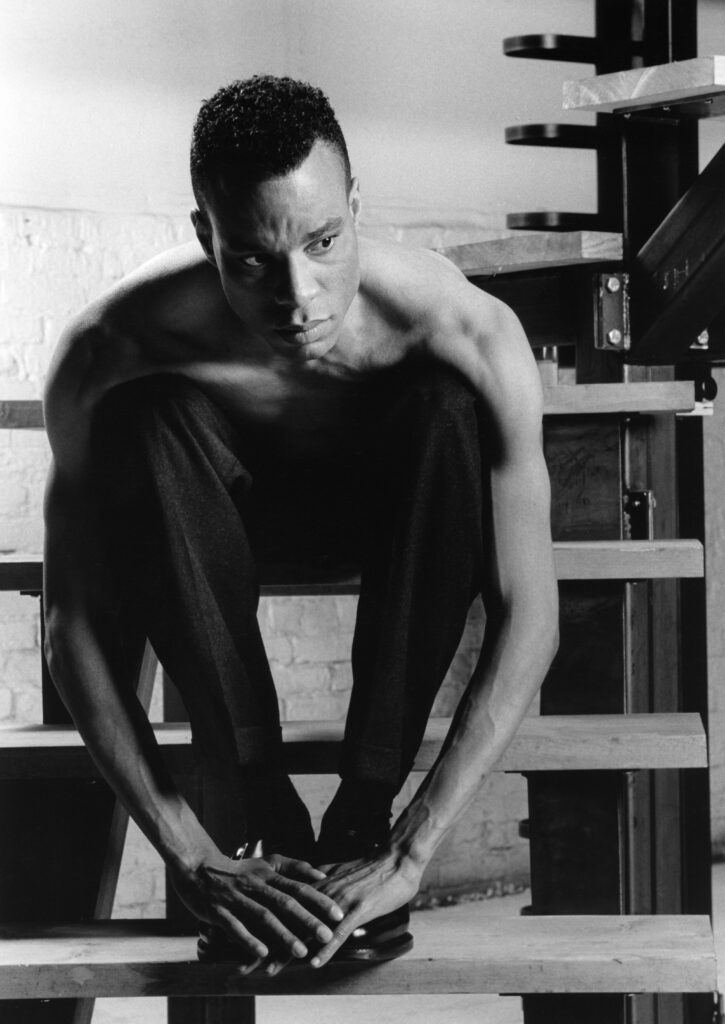Canadian Opera Resource
Canadian Opera Resource
COR
Operas
Content warning: colonial violence, colonialsm, death, illness
1828, Notre Dame Bay, on the northeast shore of Newfoundland. William Cormack, an explorer and anthropologist, has recently created the Beothuk Institute: an organization designed to prevent the extinction of the original inhabitants of the island. After learning that a Beothuk wo...
1828, Notre Dame Bay, on the northeast shore of Newfoundland. William Cormack, an explorer and anthropologist, has recently created the Beothuk Institute: an organization designed to prevent the extinction of the original inhabitants of the island. After learning that a Beothuk wo...
Composer: Dean Burry
Librettist: Yvette Nolan
Content warning: sexual violence, incarceration, religious abuse, homophobia, conversion therapy
Through several vignettes, Forbidden examines the idea of rules and taboos. Do they protect people, or do they control them? Are they of any value, or do they simply exploit the powerless?
A young girl, punished with repetition of religious tex...
Through several vignettes, Forbidden examines the idea of rules and taboos. Do they protect people, or do they control them? Are they of any value, or do they simply exploit the powerless?
A young girl, punished with repetition of religious tex...
Composer: Afarin Mansouri
Librettist: Donna-Michelle St. Bernard
Content warning: illness, death, HIV/AIDS
Dark Star Requiem is a poetic chronicle of the 25 years (as of 2010) of HIV-AIDS, reflecting the many faces of the disease and those affected by the pandemic.
Dark Star Requiem is a poetic chronicle of the 25 years (as of 2010) of HIV-AIDS, reflecting the many faces of the disease and those affected by the pandemic.
Composer: Andrew Staniland
Librettist: Jill Battson
A historical reenactment: Prime Minister Stephen Harper sets off to the Arctic to claim dominion over a particular ice floe. Mr. Valernikov, a Russian seal, mistakes Harper for a full-figured female seal and propositions him. After sorting out the misunderstanding, Valernikov claims Harper is in Russian waters. Harper, chagrined, tries to make h...
Composer: Norbert Palej
Librettist: Charles Hayter
Content warning: death, murder, suicide, xenophobia
Jason, an army captain and now war-hero, is returning home after years of war and an uncertain future. His interpreter and lover M’dea and their son Chase accompany him to a new life in the West. Jason begins a political career, working alongside the President and Dahlia, the President’s bea...
Jason, an army captain and now war-hero, is returning home after years of war and an uncertain future. His interpreter and lover M’dea and their son Chase accompany him to a new life in the West. Jason begins a political career, working alongside the President and Dahlia, the President’s bea...
Composer: John Harris
Librettist: Marjorie Chan
Content warning: illness, death, colonialism
Facing South is inspired by the life story of American Arctic explorer, Rear Admiral Robert Edwin Peary, and his contested discovery of the North Pole in 1909. The opera takes place in the inner landscape of Peary’s mind during the last hours of his life in February 1920, as he lies dying of pernic...
Facing South is inspired by the life story of American Arctic explorer, Rear Admiral Robert Edwin Peary, and his contested discovery of the North Pole in 1909. The opera takes place in the inner landscape of Peary’s mind during the last hours of his life in February 1920, as he lies dying of pernic...
Composer: Linda Catlin Smith
Librettist: Don Hannah
Anna and Michael are successful young filmmakers from Alberta, married in life and in art. Their latest project is a movie about Martin Frobisher, Elizabethan pirate and explorer who made three perilous journeys to the Arctic in the 1570s. History says that Frobisher failed in his attempt to find the fabled Northwest Passage, a quick route thro...
Composer: John Estacio
Librettist: John Murrell
Content warning: genocide, colonialism, death, gun violence, death of a child, violence against animals
“Nothing is as comforting as captivity.”
Beth, a young diplomat, and her husband Andrew are stationed at a Canadian Embassy in Africa. They are troubled by news of political upheaval, forced migrations and indiscriminate slaughter. They ...
“Nothing is as comforting as captivity.”
Beth, a young diplomat, and her husband Andrew are stationed at a Canadian Embassy in Africa. They are troubled by news of political upheaval, forced migrations and indiscriminate slaughter. They ...
Composer: Rodney Sharman
Librettist: Atom Egoyan
Consisting of 18 scenes, the opera covers 16 years in the life of Manitoba school teacher and Métis hero Louis Riel, from the Red River Rebellion (1869–70) to the North-West Rebellion (1884–85), and his trial and hanging in Regina in 1885. It also dramatizes the political scheming in Ottawa that resulted from Riel’s actions, as well as several ...
Composer: Harry Somers
Librettists: Mavor Moore, Jacques Languirand
COR
Excerpts
Cormack tries to raise funds for Shanawdithit’s care without success. James Simms offers to care for her while Cormack is away.
Lucifer is enraged at the unfairness put upon him. The Child sees, and has an idea. Perhaps the system should be broken. When Lucifer realizes the Child has seen his truth, he tries to hide his emotions.
A watcher looks over a group of faithful. His irritation turns to hatred as he accuses them of subversion. He claims to have proof hidden in some papers, but the Child has destroyed them. The Child proclaims “I know what to do,” and the tension between authority and people escalates. The Child begins taking pages and notes from all the surroundi...
While claiming sovereignty of an ice floe, Harper meets a seal, then drowns as the floe melts.
Her health fading, Shanawdithit wonders if she’ll be welcomed into the spirit world after so much time with the colonists. Cormack tells her he must leave, and Shanawdithit gives him a sketch of his house to carry with him. He leaves the room to pack. Shanawdithit hears the spirits of her people calling her name. It is time. One spirit in partic...
Jason, M'dea, and the soldiers return from war to a celebratory crowd. Some do not trust the new foreigner, M'dea.
At a party, the Corporal mocks Jason for needing M'dea to help him win and for bringing her home.
Shanawdithit describes the last days of her family as they were pushed from their land and then hunted. She asks Cormack not to speak of their death, but of their life. Cormack is ecstatic and gets lost in the memories Shanawdithit paints. She breaks his reverie with the cold fact that the life she speaks of will never happen again. She collapse...
At the President's office, Jason and the President discuss family, how to be a good father, and a possible future for Jason in politics.
In a dream state, M'dea recalls all she has done to survive.
Henson helps Minik reach the land of the dead; Peary and Josephine argue about Peary's Inuit children.
Shanawdithit, dying, speaks to her ancestors. She is ready to leave this world.
Cormack presents his findings about Shanawdithit to the members of the Beothuk institute.
Shanawdithit reprimands Cormack for his saviour complex.
Cormack meets Shanawdithit for the first time. She’s been working as a servant for Peyton for five years under the colonial name of Nancy April. Cormack is awed; he believes this woman is the last of the Beothuk. Peyton gives her to him, saying she’s useless.
Cormack’s study in St. John’s, now Shanawdithit’s room. “Nancy April” reveals she can speak English quite well, and tells Cormack her real name: Shanawdithit. Cormack asks her where the rest of her people are, where her home is. Shanawdithit says simply: they are no more. Shanawdithit reflects on the loss of her people and the taking of her aunt...
The taking of Demasduit weighs heavy on Shanawdithit’s heart. Cormack, unsure of what to do, tries to comfort her, saying Demasduit was treated well. Shawnadithit asks if white people actually care about her people, her story, because Cormack’s words are betrayed by the actions of his fellows, and indeed, his own. Cormack insists he will ensure ...
Eugene is dying. He has left some of his and Antoine's things for Malcolm, but Malcolm is growing angrier at Antoine who still will not write him a letter of recommendation.
A group of people discuss the dynamics of Polygyny before the arrival of colonizers and missionaries.
Malcolm describes his sense of suspension in time and space as we hear gunshots outside.
Beth and Andrew are getting ready for bed. Malcolm enters suddenly, claiming that someone will be there soon and leaves as suddenly as he arrived.
Some years prior, Eugene and Antoine enter the residence, Malcolm, their new houseboy (who does not speak much English) helps them unpack. Antoine and Eugene ask Malcolm if he is married, and he replies that he wants Eugene to be his girlfriend. Malcolm asks Eugene to teach him words.
Beth reads Andrew a memo from a political figure denying the murder of innocent people and claiming that suspensions of civil liberties are essential. Beth and Andrew go downstairs for dinner, where Malcolm has prepared them a live monkey.
Malcolm tells Eugene and Antoine that he wants to go to university and asks for a letter of recommendation. Antoine tells him that he should stay in the house with the people who love him.
Beth and Andrew are moving into the residence. They begin a conversation with Malcolm similar to that of Eugene and Antoine in scene 2. Malcolm explains that he once had scholarships to university because of a good recommendation letter.
Malcolm and Eugene are dancing, but we quickly learn that they are practicing English. Malcolm asks if Antoine has written the letter of recommendation yet. Eugene tells him he is not ready yet. Malcolm grows frustrated.
The action continues from scene 3. Beth and Andrew are waiting for their guest, Duncan, but Antoine arrives instead and cuts into the live monkey's skullcap without hesitation. He recounts how he almost wrote Malcolm a letter of recommendation.
Malcolm works on his university application; Eugene is sick. Antoine arrives telling them he has been promoted to ambassador, but that they will remain in the country they are currently stationed in.
The political situation is worsening, and Andrew and Beth decide to invite Antoine, the ambassador, over for drinks. Violence errupts in the streets as Malcolm has gone out to the garden. He returns holding the body of a child.
Josephine wonders what discovery is worth.
Beth and Andrew demand Antoine that they be allowed to leave. He will keep them there forever because he wants to see them all become heroes and redeem his initial banishment with Eugene. Antoine grabs the dead monkey and begins to dance with it. A bullet explodes through the window, hitting Antoine and he falls to the ground.
Upstairs, Malcolm reads another memo from Antoine. Beth rushes in to tell him that it's time to leave. Andrew and Beth leave the house, but Malcolm remains in the house, still surrounded by violence.
Two explorers close to the north pole - the explorer Peary becomes confused.
An ill and delirious Peary reminisces about his polar days; his wife remembers their early love.
Peary is unsure if they have reached the North pole.
Josephine asks for Henson's help, despite Peary's past bad treatment of him.
Minik remembers Greenland.
The explorers make a plan to bring the Inuit to America to make money.
Peary and Henson once again try to confirm they are at the North pole.
Peary and Henson believe they have reached the North pole.

